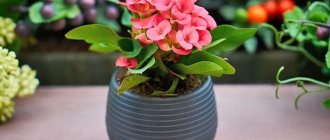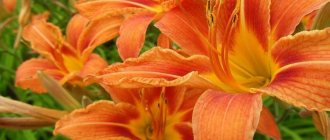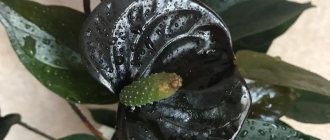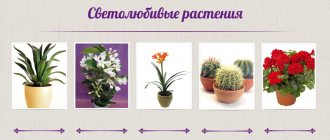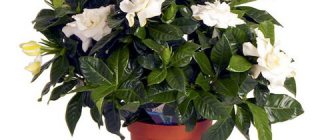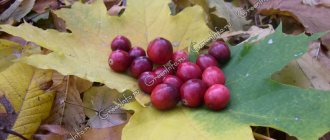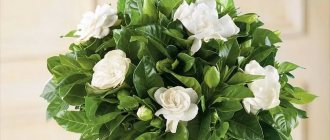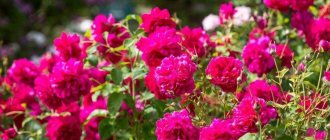Long-flowering plants in the flowerbed will help maintain the beauty of the garden from early spring until late autumn. Crops that bloom for a long time are usually unpretentious in care. To decorate a not very large garden or plot, gardeners prefer to choose plants that can delight with their flowering for a long time. In this case, it often becomes necessary to plant low-growing varieties.
As a rule, low-growing garden crops are more often used in garden decoration compared to tall ones. Along with the fact that they perform their main function, such plants are also widely used for decorating rock gardens and borders, creating decorative borders, and also for planting around shrubs and trees. Below we will consider those low garden crops that can decorate a flower bed throughout the summer.
Photos and names of decorative indoor plants
Ornamental plants are valued for flowers of various shapes and colors, unusual foliage, and a variety of forms, including erect, creeping and hanging, herbaceous and tree-like.
Indoor flowers can be of local origin and come from the most remote corners of the world. Such plants differ not only in appearance, but also in habits, and require different conditions of maintenance and care. Some people are passionate about succulents, while others are more interested in watching the growth of epiphytes. Although it is almost impossible to get acquainted with all types of home flowers, their photos and names, a short catalog will be an excellent help in choosing a “green pet” to your liking.
Abutilone
Abutilon
Shrub (up to 2 m) with heart-shaped leaves about 10-20 cm long. Flowering is long and lasts until late autumn. The flowers are bright, different in color. Outwardly they resemble bells.
Abutilone prefers heat, light and moisture. The ideal growing temperature is not lower than 20°C.
Other names: “Indoor maple”, “Chinese lanterns”, “Rope tree”.
Belongs to the Malvaceae family.
Aloe - an ancient healer
Requiring very little care, aloe (popularly used as both aloe and aloe) is a real pharmacy in a flower pot. Refers to succulents that do not need to be watered frequently in summer, and in winter - maximum once a month. But all succulents need a lot of light, so the only place for it is on the windowsill.
To take advantage of the healing properties of aloe, you need to let the bush grow: to treat runny noses, ulcers, skin injuries and other ailments, you need the pulp and juice of a plant that is at least three years old.
Anthuriums / Anthurium
Anthuriums (lat. anthurium) are evergreen perennial semi-epiphytic flowering indoor plants . Anthuriums are also called fire tongue, flamingo flower or male happiness.
Archontophoenix cunninghamiana
Cunningham's archontophoenix (lat. archontophoenix cunninghamiana) are monoecious palms with a straight ringed trunk.
Azalea
Azalea
An ornamental shrub of rhododendrons up to 0.5 m high. The leaves are small (3.5 cm) with short petioles of dark green color. The color of the flowers is red in various shades. Azaleas need to be shaded and additionally highlighted in the fall. Growing temperature is room temperature. Prefers high air humidity.
Avocado
Persēa americana
A small tree with a thin trunk and large oval leaves.
Avocado prefers a temperature of about 20°C, regular watering once every 1.5 weeks, high humidity and lighted spaces. Does not tolerate direct sunlight, so it is best to place the plant in the back of the room
INTERESTING. Avocados can be grown from fruit seeds purchased at the store.
Abutilone or indoor maple
The plant received its name because of its leaves, which are similar to maple leaves. Abutilon blooms from spring to autumn. Its flowers can be: funnel-shaped, bell-shaped or wheel-shaped. Flower color: white, pink, red, yellow.
Indoor maple will bloom in the autumn-winter period if it is provided with additional lighting. You should also fertilize the plant with nitrogen or phosphorus fertilizers.
Aglaonema
The Aglaonema plant is a member of the aroid family. This genus includes about 20–50 species. The plant is naturally found in rain forests.
Decorative leaf begonias / Begonia
Decorative begonias (lat. begonia) are bushy indoor plants with fleshy stems or flexible, hanging petioles.
Impatiens / Impatiens
Impatiens (lat. impatiens) are perennial bushy, unpretentious flowering indoor plants with succulent, fragile, erect stems.
Vanda / Vanda
Vandas (lat. vanda) are epiphytic or lithophytic orchids with 1 stem, with thick aerial roots, of impressive size.
Gasteria / Gasteria
Gasteria (lat. gasteria) are succulent plants with elongated leaves similar to a cat's tongue.
Hibiscus
But this is not really a flower, but a shrub that came to the Old World from the hot tropics. Evergreen hibiscus, blooming from early spring to late autumn, will decorate the room.
It should be kept in the southern part of the house, where there is a lot of light, and watered regularly and preferably with settled, not cool water.
The only thing that this most beautiful of shrubs cannot tolerate is sudden temperature changes and drafts.
12
Geranium
Without exaggeration, this is one of the most popular indoor flowers. It has unique qualities:
- The aroma of geranium can relieve headaches, and it is recommended to rub the essential oil into the temples even for migraines.
- Normalizes sleep, relieves irritability and nervous excitability.
- A unique set of microelements allows geranium to literally disinfect the air around it.
- Repels insects. In a house where geranium blooms, you will not find mosquitoes, flies and moths.
- It is believed that geranium protects love and harmony. Such a house is bypassed by dark forces, but if the plant withers, it means that one of the relatives will soon fall ill with a serious illness.
In addition, geranium is simply very beautiful and easy to care for.
Dieffenbachia
Native to South America, this flower with striped leaves is an evergreen shrub. This feature keeps the leaves bright green even in winter in an “apartment” climate. Sometimes during the cold winter season, Dieffenbachias may turn pale, but still retain their green color. In apartment conditions, this shrub practically does not bloom, and its flowers do not represent an aesthetic value compared to the leaves.
In addition to aesthetic pleasure, the plant is able to ozonate the air in the room, slightly controls humidity, and is also capable of purifying the air not only of dust, but also of some harmful compounds. It is believed that the “healthy” flower can even help with allergies .
However, this plant has a serious disadvantage - poisonous sap. It is poisonous to both people and animals.
When propagating flowers from cuttings without gloves, you can get your hands burned. If the juice gets on an open area of skin, an ulcer may appear. If a child or pet chews a leaf of the plant, anaphylactic shock may occur.
Dizygoteka
Dizygotheca
A herbaceous plant that is distinguished by very thin leaves with a curly edge. It hardly blooms at home.
When growing Dizygoteca, temperature changes, drafts and dry air are not allowed. During the growing season and flowering, mineral fertilizers must be applied every 2 weeks.
Belongs to the Araliaceae family.
Davallia
Davallia
A fern plant with “hairy” roots that grow from the soil and hang down from the pot. Otherwise, it looks like an ordinary fern.
Care tips: you need to spray it 2 times a day and ventilate the room.
Davallia is also sometimes called “Hare’s Foot”, “Deer Foot”.
Jasmine
Jasminum
A small bush with densely growing oval leaves and snow-white fragrant flowers.
Jasmine does not like drafts; when caring for it, it prefers high humidity, watering every 3 days and diffused sunlight.
INTERESTING! During the dormant period it can withstand short-term temperature drops of up to 8-10°C.
Zamia
Zamia , family Zamiaceae
The plant looks a bit like Zamioculcas. It differs from it by a powerful short trunk, similar to a pineapple, and a cone-shaped inflorescence, similar to an ear of boiled corn.
Zamia loves bright sun, but to prevent the leaves from overheating, it is necessary to provide the flower with air flow. Also, during the growing season, the pot with the plant must be rotated so that the plant grows evenly.
Zamioculcas
Purifies the air by preventing the accumulation of CO2 in confined spaces. Able to relieve chronic pain, relieve migraine attacks, stabilize sleep and improve its quality.
Figs
Ficus carica
It has maple-shaped leaves.
At home it is grown from cuttings and grows to a small tree.
Needs spraying and abundant watering all year round, with the exception of the fruiting period.
Schlumberger
This is one of the few plants that grows on the windowsills of all houses and apartments. At a time when the choice of home flowers was not as great as it is now, this lovely plant delighted the eye with bright flowers at the very beginning of winter. In late autumn it produces many buds to open and bloom in December. That is why it was nicknamed “Decembrist” or “Barbarian flower” - at the very peak of its flowering - December 19, Varvarin Day is celebrated according to the Orthodox calendar .
Many people think that this forest cactus needs a lot of light for good and comfortable flowering. This is a mistake, since this type of indoor plant does not receive much light in nature due to trees.
The most optimal for it would be a northern or western window sill. Southern and eastern exposures are acceptable with slight shading.
Many flower growers wonder whether Decembrist also needs additional lighting, because it blooms in winter, when daylight hours are as short as possible. No, he doesn't need it. This is due to the fact that the blocked buds must survive a cycle of a gradual decrease in solar activity and a decrease in daylight hours.
Decembrist loves very loose soil, without the slightest stagnation of water in it. In nature, these plants live on trees and between stones, where there is no fluid retention.
The crop needs to be watered as the top layer of soil dries out. The roots should not be allowed to dry out, but there is no need to keep them constantly wet either. From late autumn, watering is gradually reduced, which leads to the formation of flower buds.
Kalanchoe
It is known no less than aloe for its unique healing qualities. It is widely used in folk and official medicine:
- heals cuts, abrasions, burns and inflammation on the skin;
- cleanses the body of waste and toxins;
- has a beneficial effect on the immune system;
- Helps in the treatment of liver and gallbladder diseases.
Croton
This species, growing in tropical and subtropical zones, has long become popular among flower growers around the world.
Its bright leaves will add variety and uniqueness to your home, or will become a real decoration for your office. Due to its shape it has become very popular among amateur gardeners.
The plant is easy to care for, and some of its species grow up to 80 centimeters in height.
Crassula
The round leaves of this plant look like coins, which is why Crassula is often called “money tree” or “crassula” among gardeners.
When it blooms, it is covered with small white flowers, sometimes red, and very, very rarely the flowers can be blue.
One of the most unpretentious room dwellers. Even a leaf that falls to the ground can sprout into a separate plant.
Clivia
Clivia is an evergreen rhizomatous plant with a powerful basal rosette of long leathery leaves. During flowering, the plant produces a powerful peduncle with bright orange-yellow corollas gathered at the top into an umbrella. At home, flowers last for more than 3 weeks.
Indoor violet (Saintpaulia)
Violet has soft energy and brings out the best in a person. It can push you to make a long-delayed decision or start a new business.
Relieves nervous tension and insomnia caused by it.
Indoor rose
What could be more beautiful than a rose, especially when it blooms on your windowsill. But this queen of flowers requires special care.
The home rose simply loves sunny color, so it is better to place it in a well-lit place on a western or eastern window.
If you care for them properly, roses will bloom all year round, every 7-8 weeks.
Mrs. Thompson's clerodendrum
In spring and autumn there is abundant flowering, in summer there is a cap of green leaves in exchange for regular watering of the soil, spraying of greenery, fertilization once a week during flowering. There are two ways to grow an unpretentious flower, which is popularly called the “tree of happiness”:
- like a vine with very quickly growing vines;
- as a compact flowering bush, for which the tips of the shoots are regularly pinched.
Large decorative leaves themselves will decorate any home. Abundant flowering creates a feeling of celebration. The watering regime is normal - between them the soil should dry out slightly. Liquid fertilizer for flowering plants is used as fertilizing.
Crossandra
Crossandra , family Acanthaceae
Bushy plant with glossy leaves.
The flowers have different colors and are interestingly arranged on top of each other like tiers.
Crossandra grows well in moderate temperatures. Afraid of direct rays of the sun.
cacti
Be that as it may, but a prickly flower during the flowering period, even if this happens very rarely, you simply cannot take your eyes off them.
And it can please you with flowering only with proper care and compliance with watering requirements. Everyone probably knows that cacti are not watered in winter.
This is a heat-loving plant, so it loves bright light and prefers to be in the southern part of the house.
Myrtle
A spectacular plant - a symbol of family happiness. Myrtle purifies the air from most known pathogenic microorganisms, refreshes the atmosphere in the room and saturates it with oxygen.
The light aroma of myrtle helps clear the mind and increase concentration, increases productivity, and helps to relax after a hard day.
Euphorbia Mile
Euphorbia Milya in Russia is better known as the “crown of thorns”. This unpretentious plant in nature reaches a height of 2 meters. In a pot, a succulent with a stiff stem covered with long thorns and a tuft of leaves at the top is much smaller. The unusual appearance of the plant is completed by small inflorescences bordered by bright bracts in scarlet, pink, yellow and white tones.
Monstera
Monstera is a beautiful evergreen plant that belongs to the liana family. This is one of the most common indoor plants. Young leaves are whole, with age they become perforated, and then completely split.
Monsteras take root ideally in heated winter gardens. The plant helps to ionize the air in the room. Monsteras take root ideally in heated winter gardens. The plant promotes ionization of indoor air.
Musa tropicana, banana
For the development of a tropical plant, it is very important to provide abundant lighting. It is best to place the banana on the south side, but the musa must be protected from direct sunlight.
The ideal option is bright but diffused light. The microclimate in the room with a banana should be very comfortable. Suitable temperature conditions are between 23 and 26 degrees Celsius.
Watering Musa Tropicana should be plentiful, about 3 times a week. Overwatering or drought should not be allowed, and between waterings the soil should have time to dry out a little.
Peppermint
It is believed that growing peppermint at home can improve well-being and attract good luck. The plant reduces anxiety, helps to relax and improves sleep quality.
The light aroma of mint normalizes blood pressure, reduces headaches and nausea.
Poinsettia ("Christmas Star")
Poinsettia
This flower is easily identified by its beautiful white-pink or bright red bracts. Externally, this plant looks like a huge flower.
The real flowers are inconspicuous and look like the yellow stamens of a large flower.
When caring, he prefers room temperature and air humidity of at least 80%. Poinsettias need to be watered 3 times a week.
Primrose
Primula , family Primroses
Primrose has beautiful flowers with petals fused at the base. There may be a spot of a different color in the center of the flower. The leaves are wrinkled and pleasant to the touch.
Primrose blooms in spring and fades in summer.
The plant easily adapts to environmental conditions, but prefers diffused sunlight.
Rebutia
Rebutia
A cactus that looks like a ball or a light bulb. It blooms with beautiful bright flowers, similar in size to the cactus itself.
One of the few cacti that takes watering easy. Reproduces by lateral shoots.
Crassula
The decorative house flowers in the photo owe their name to their fleshy, coin-like leaves. Crassula or “money tree” is an excellent houseplant that even a beginner can care for. In terms of endurance and easy propagation, the flower can only be compared with Kalanchoe. Even a fallen leaf soon takes root and gives rise to a new plant.
Chlorophytum - the best air purifier
Leader of the list of the most unpretentious indoor plants. Growing quickly on brightly lit window sills and in wall planters in the shade, it is considered an excellent filter that cleanses the air of various impurities. Therefore, chlorophytum is often prescribed in the kitchen.
Chlorophytum
Moderate watering, once a month fertilizing with a universal complex from spring to autumn, spraying, especially in winter, when the air is “burned out” by heating - this is enough for the tufted beauty to spread leaf feathers in all directions and hang rosettes on long peduncles.
Ficus
One of the most beloved plants by all gardeners. The reason for this is the beauty of its leaves and their decorative effect. A large number of varieties of this flower are grown at home:
- rubber;
- lyre-shaped;
- Benjamin;
- dwarf.
Although outwardly different from each other, they are kept the same. Caring for them is very simple.
A large amount of light is the most important condition for high-quality growth of ficus. In winter, when daylight hours become short, ficus requires additional lighting. Lack of light is the main cause of leaf fall. Daylight hours for the growth of this crop must be at least 12 hours.
In summer, the described plant requires abundant watering, and in winter - moderate. The soil should dry out a little between waterings, but not dry out completely. In winter, excess moisture is not allowed, as this can lead to rotting of the roots and sometimes the base of the stem.
Erika
Erica
A shrub with small bell-shaped flowers of white or purple color.
Blooms from early winter to late spring.
During the growing season it requires a lot of light and water.
Represents the Heather family.
Eustoma
Eustoma
A herbaceous shrub with large flowers that look like a rose or a bell. The coloring varies, but is always very interesting. The leaves resemble slightly elongated and rounded triangles.
Eustoma requires a period of rest with mandatory pruning. The plant needs to be watered twice a month.
Represents the Gorechak family.
Yubelmania
Uebelmannia
A spherical cactus with a large number of edges.
With age, it can stretch out and become like a light bulb. The color is variegated.
Unlike other cacti, it requires shading from the midday sun.
Yucca
Yucca , family Agave
Looks like a small tree. Most often, the trunk looks like a mountain (thick at the bottom, narrow at the top). The leaves are long and sharp, looking like spear tips.
Yucca blooms only in natural conditions. Does well in hot weather and bright sun.
Succulent indoor plants (photos and names)
Succulents are a large group of plants native to the southern arid countries that store moisture inside their stems.
Kalanchoe (lat. kalanchoe)
A variety of succulents with carved oval leaves and wonderful long flowering. The leaves can be either smooth or velvety, with a striped underside. Some species have small shoots at the tips of the leaves that easily fall off and germinate immediately - a simple and convenient way to propagate a plant.
Flower petals are collected in a cup, or can be drooping inflorescences. There are a lot of buds, but they do not all bloom at once. Kalanchoe loves light windowsills, but without a lot of direct sunlight. Water twice a week in the warm season, and in winter no more than 2 times a month. The life of a plant in an apartment lasts up to 6 years, and large varieties live for 10 years.
Kalanchoe: care at home, beneficial properties of the plant In a special publication on our portal, we will tell you in detail about Kalanchoe, what types it comes in, what beneficial properties it has, how to properly grow, propagate, feed and pruning.
Schlumbergers (lat. schlumbergera)
A wonderful forest cactus that is strewn with flowers in winter. The plants are popularly called Decembrists.
Schlumberger
Only non-hybrid forms of cactus have a spine. Flowers are scarlet, pinkish, white, both with bent petals and not. Flowering lasts throughout the winter months.
Place the pot in a bright window with diffused sunlight and water once a week until December, and during flowering, and also every three days from late spring.
ADVICE!
During flowering, the pot is not moved.
Sedum (lat. sedum)
One of the most unpretentious succulents with exotic appearance. The dense leaves appear dense, fleshy, oblong or rounded. The plant blooms with star-shaped yellow, red or white flowers.
sedum
Sedums prefer a bright place, with shade at midday. The plant is watered once a week starting in March. In winter, it is enough to water once a month.
Where and how to use paper flowers
Flowers always bring joy to people and a special mood. In the spring, after a long winter, people always look forward to when primroses and dandelions begin to bloom in gardens, parks and summer cottages. Everyone rejoices at them, just as children rejoice at their new toys. Paper flowers have long been used for decoration, especially at various holidays and celebrations. They decorate:
- festive table at weddings, anniversaries or corporate events. By the way, watch the video on how to make beautiful asters for festive table decor;
- various interiors, halls, foyers, stages;
- areas for photo sessions;
- festive hairstyles and outfits (in this case, headbands and hairpins are decorated with flowers, beautiful brooches and boutonnieres are made from them);
- boxes and packaging for gifts;
- photo albums, photo frames;
- Greeting Cards.
Paper flowers are given both as a separate gift and as an addition to the main present. Here is a video example of how to make incredibly beautiful white and pink peonies as a gift from ordinary table napkins.
Bulbous indoor plants photos and names
The catalog presents indoor flowers with shoots in the form of bulbs. It is in them that plants accumulate useful substances. Many crops completely shed their leaves during the rest period. Most of the domestic flora representatives have beautiful and large flowers. Only a few are valued for their unusual leaf shape.
Weltheimia
The flower grows up to 60 cm with large roots, bare plump stems, and mundane leaves. A peduncle with thick clusters of red, pink, yellow tones blooms in a cool room from January to March. The inflorescence is unique and showy. Depending on the conditions of detention, it can live from 1 to 5 years.
Hemanthus
The culture grows in Africa. It grows in height up to 30-40 cm. It is distinguished by shaggy inflorescences. It blooms in red and beige, usually in spring and summer. From one bulb grows 2-6 leaves, fleshy or transversely leathery. At home, only hybrid species are found.
Roses
0
Source:
This example is suitable for postcards. The option with a simple rose will pleasantly surprise you. This type of technology is interesting to implement and does not require any additional costs. It's done very quickly. And I even present to you 6 ways to make a variety of roses. Option 1 For this you will need: colored paper PVA glue scissors pencil Procedure: Take colored paper and roughly draw spiral lines along it. We cut out a spiral along a given line in a circle. Then we twist the rose and glue the ends together. The rose turned out quite quickly and beautifully. This design will serve as a wonderful rainbow accent on the card.
Popular plants
- Zamioculcas (Dollar Tree)
- Kalanchoe
- Spathiphyllum
- Dracaena
- Poinsettia (Christmas Star)
- Cyclamen
- Poinsettia (Christmas star)
- Ficus benjamina
Sources
- https://glav-dacha.ru/komnatnye-cvety-katalog/
- https://WhatFlower.ru/houseplants/katalog-komnatnyx-rastenij-s-foto-i-nazvaniyami/
- https://zen.yandex.ru/media/id/5c151cc0330a1400aacd326f/samye-neprihotlivye-komnatnye-cvety-i-rasteniia-uhod-za-nimi-5c16b21b2fb96d00aa8d19e4
- https://rasteniya.dp.ua/ru/komnatnie-cveti/
- https://moyasotka.com/tsvety/komnatnye
- https://zen.yandex.ru/media/moiorhidei/14-neprihotlivyh-domashnih-rastenii-kotorye-mogut-cvesti-kruglyi-god-5d9da6771ee34f41895508c9
- https://uutvdome.ru/bol-komn-ras
- https://most-beauty.ru/nature/samye-krasivye-komnatnye-tsvety.html
- https://RoomFlower.ru/poleznoe/poleznye-komnatnye-rasteniya.html
- https://stroy-podskazka.ru/komnatnye-cvety/samye-populyarnye/
- https://agronom.guru/komnatnye-cvety-s-foto-i-ih-nazvaniyami
- https://rastenievod.com/category/komnatnye-rasteniya
[collapse]
